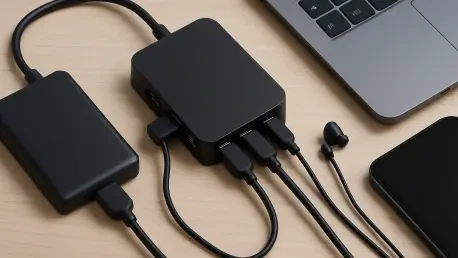Today, we’re diving into the world of USB connectivity solutions with Nia Christair, a renowned expert in mobile technology and hardware design. With a rich background in mobile gaming, app development, and enterprise solutions, Nia brings a unique perspective on how we can maximize our device connectivity in an era where USB ports are in high demand but often short supply. In this interview, we’ll explore the growing need for additional USB ports, the benefits and varieties of USB hubs, the potential of powered hubs for heavy users, internal expansion options for desktop users, and innovative ways to integrate ports into existing setups.
How do you see the increasing demand for USB ports impacting users in their day-to-day tech interactions?
Honestly, it’s a real pain point for a lot of people. With modern laptops often shipping with just one or two USB-C ports, and desktops getting crowded with peripherals like keyboards, mice, webcams, and controllers, users are constantly juggling connections. I’ve seen this firsthand in mobile gaming setups where you need ports for controllers, headsets, and charging—all at once. It’s frustrating to unplug one device just to make room for another, and it disrupts workflows, whether you’re gaming, working, or creating content.
What kinds of devices do you find yourself connecting to your computer that eat up those precious USB ports?
For me, it’s a mix of work and play. I’ve got my keyboard and mouse as staples, but then I’m also plugging in external drives for app development projects, a webcam for virtual meetings, and often a controller for testing mobile games. If I’m on the go, I might need to connect a portable charger or a card reader for quick data transfers. It adds up fast, and I’m sure many users can relate to that constant port shortage.
Can you share your thoughts on USB hubs as a quick fix for this shortage, and how they’ve worked for you?
USB hubs are a lifesaver, plain and simple. I’ve used them for years, starting with basic models that just give you a few extra USB-A ports for under $20. They’re plug-and-play, no hassle, and perfect for laptops or small desk setups. I’ve got a compact one for travel that’s barely noticeable, and it’s been great for connecting essentials on the fly. They’re not just about quantity; they’ve evolved to offer so much versatility, which makes them a go-to solution for most people.
When it comes to choosing a hub, do features like HDMI or SD card slots catch your eye, or do you stick to the basics?
It really depends on the user’s needs, but I lean toward hubs with extra features. For someone like me who works with mobile app development, having an SD card slot right on the hub is a game-changer for quick file transfers from cameras or other devices. HDMI is a bonus too, especially if I’m connecting to an external display for presentations or testing. While a basic hub is fine for simple setups, these multi-function hubs add a layer of convenience that’s hard to pass up, especially for laptops lacking those ports natively.
What’s your take on powered USB hubs for folks who need a lot more ports or power for their devices?
Powered hubs are fantastic for power users. If you’re running a setup with 7 to 10 devices—like external drives, charging cables, and high-demand peripherals—a powered hub is almost a necessity. The external power supply ensures that all your devices get enough juice without draining your computer’s resources. I’ve used them in setups where I’m charging multiple devices at once, and features like individual power switches are incredibly handy for managing what’s active. They’re a bit pricier, around $50, but for the stability and capacity, they’re worth every penny.
How much do factors like data transfer speed influence your decision when picking out a hub?
Data transfer speed is a big deal, especially for me since I’m often moving large files for app testing or game development. A hub with 5Gbps speeds, which is pretty common in mid-range models, makes a noticeable difference over older, slower options. If you’re just using a hub for a mouse or keyboard, speed might not matter, but for external drives or card readers, it’s critical. I always advise checking the specs because a slow hub can bottleneck your workflow, and that’s a frustration you don’t need.
Have you explored internal solutions like PCIe USB expansion cards for desktops, and what do you think of them as an alternative to hubs?
Absolutely, PCIe cards are a great option for desktop users who want a cleaner setup without extra cables cluttering their space. I’ve installed a few for clients, and they’re awesome because they add ports—often a mix of USB-A and USB-C—directly via the motherboard. It’s a more permanent solution, and since it doesn’t hog an existing USB port, it’s efficient. The installation isn’t too tricky if you’re comfortable with hardware, similar to slotting in a graphics card, but it’s not for everyone. I’d recommend it for gamers or creators who need a dedicated, high-speed port setup.
What are your thoughts on integrating USB ports into other devices, like monitors, to solve the port shortage issue?
I love this trend of monitors with built-in USB hubs. It’s such a smart way to declutter your desk while adding functionality. I’ve used monitors with a few USB 3.0 ports, and they’re perfect for connecting a keyboard, mouse, or even a controller without running extra cables to the PC. It’s not going to replace a dedicated hub if you need tons of ports, but for minimal setups, it’s a sleek solution. Just make sure to connect the monitor’s USB cable to your PC to activate those ports, and sometimes you might need drivers, so check the manual.
What’s your forecast for the future of USB connectivity as devices continue to evolve?
I think we’re heading toward even more integrated and versatile solutions. USB-C is already becoming the standard, and I expect future devices to lean heavily on multi-function hubs and docks that combine power delivery, data transfer, and video output in one tiny package. We might see more wireless solutions reducing the need for physical ports, but for high-speed, reliable connections, USB isn’t going away anytime soon. I also predict smarter hubs with built-in software for managing connected devices, making it easier to prioritize or toggle connections. It’s an exciting space to watch!









